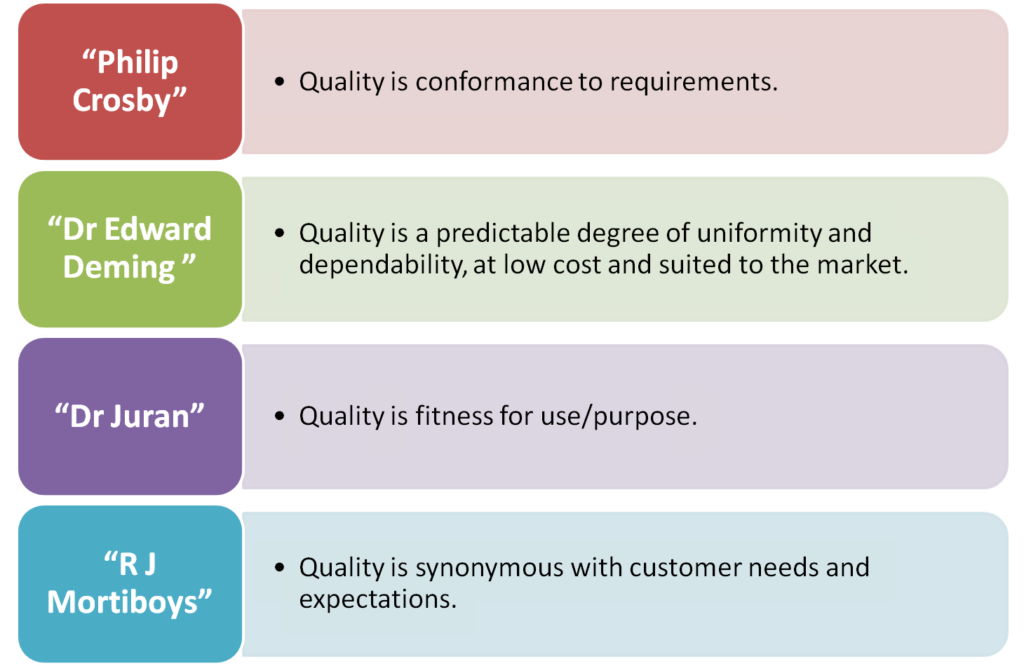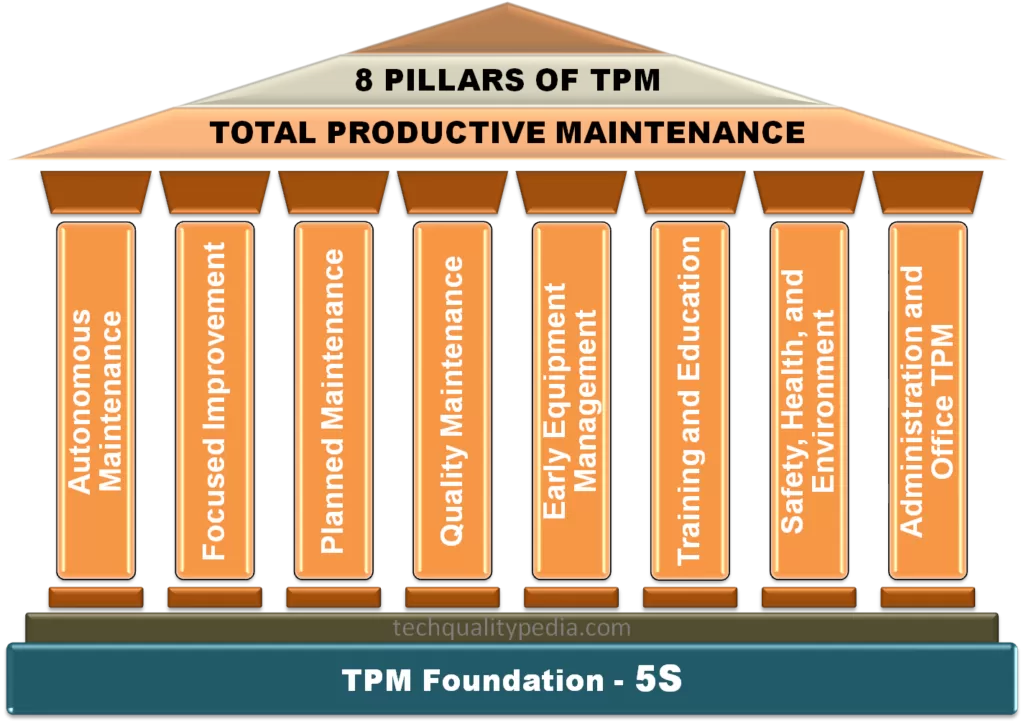Qualitymeans “Performance upon expectations” and “fit for functions.”
A product is said to be of good quality if it satisfies the customer’s requirements in terms of performance, grade, durability, appearance, and intended use/purpose, etc.
Table of Contents
Quality Definitions | Meaning
The word “Quality” has a variety of meanings and definitions which are mentioned below:
Fitness for use/purpose
The component is said to possess good quality if it works well in the equipment for which it is meant. In other words, the product should be suitable for the intended use/purpose. Thus it is defined as fitness for purpose.
For example, a gearutilized in a sugarcane juice extracting machine might not possess a good quality surface finish, tolerance, and accuracy as compared with the gear utilized in the top stock of a lathe.
But still, it may be considered of good quality if it works satisfactorily in the juice-extracting machine. Therefore, quality is defined as “the fitness for use/purpose” at the foremost economical level.
Conformance to requirements
It is the ability of the material or component to perform satisfactorily in the application for which it is intended by the user. Quality of a product, thus, means conformance to customer’s requirements. This is a Manufacturing-based definition.
Grade
It is a distinguishing feature or grade of the product in appearance, performance, life, reliability, taste, and maintainability, etc. This is generally called quality characteristics.
Degree of Excellence
It is a measure of a degree of excellence at a suitable price and control of variability at a suitable cost. this is often a Value-based definition.
Degree of preference
It is the degree to which a particular product is preferred over competing products of similar grade, supported comparative tests by customers, normally called customer preference.
A measure of the fulfillment of promises
The Quality of a product may be a measure of the fulfillment of the guarantees made to the purchasers/users.
British Defence Industries Quality Assurance Panel
Quality is conformance to specifications.
Definition by ISO
The totality of features and characteristics of a product or service that bear on its ability to satisfy stated or implied needs revolves around the customer.
Quality Definitions by “QUALITY GURUS”


For better clarity of the “Quality” term, we must learn and understand the concept/ meaning of the following topics:
Quality Assurance
QA contains all those planned and systematic actions necessary to supply adequate confidence that a product or service will satisfy/fulfill given requirements for Quality.
QA includes QC, but it emphasizes quality in the design of products and processes.
Quality Control
QC is the process through which we measure the actual quality performance and compare it with the set standards.
And if there is a deviation then we take corrective actions.
Typically quality control program is based on periodic inspection, followed by feedback on the results and change or adjustment whenever required.
Quality System
A Quality System is the company-wide and plant-wide operating work structure, responsibilities, procedures, and processes for guiding the coordinated actions of the workforce, the machines, and the information of the organization in the best and most practical ways to assure customer satisfaction. Quality Assurance and Quality Control both are part of the quality system.
Total Quality Management – TQM
It aims to involve every person from every function or department of an organization working together to eliminate defects/errors and prevent 3M Waste from the manufacturing process.
Six Sigma Quality
Six Sigmais aquality management concept/philosophy and a methodology that emphasizes variation reduction, defects elimination, and improving the process and product quality, and services. Six Sigma is also defined as a methodology for quality problem-solving. A product is said to be of 6sigma (6σ) quality if there are no more than 3.4 defects per million opportunities(DPMO) at the part and process step level.
Quality Management System Standards
The quality system standards define the method of managing quality in a company to ensure that products conform to the set quality level.
A company is free to set the quality standard or level for its products based on marketing considerations and customer requirements.
Seven Basic Quality Tools
Also known as 7 QC Tools of Problem-solving. These are graphical and statistical tools that are widely used to analyze and solve work-related problems.
Quality Circle
Originally known as Quality Control Circle. QCC’s objective is to get associates involved in the improvement process and problem-solving.
QCC is a group of employees whose assignment is to identify problems, formulate solutions, and present their results to management with suggestions for implementation.
Statistical Quality Control-SQC
Use of statistical techniques (like SPC, MSA, Gage R &R, Quality Control tools, Control Charts, etc.) in controlling product and process quality.
Statistical Process Control-SPC
The SPC technique is used to measure the Process Capability of the production process. This technique is widely applied in the Automotive, Engineering, and Manufacturing industries to monitor and control the manufacturing process and eliminate the Common cause and Special cause of variations.
Quality Audit
A systematic and independent examination to determine whether quality activities and related results comply with planned arrangements or defined standard operating procedures.
> Explore System Audit, Process and Product Audit
Quality Characteristics
An element that makes the product fit for use is the quality characteristics.
A physical or chemical property, a dimension, appearance, temperature, pressure, taste, smell, or any other requirements used to define the nature of the product or service is a Quality Characteristic.
Cost of Quality
COQ is a measure of the cost to the firm for a lack of quality.
COQ is divided into two main categories – Cost of conformance and Cost of Non-conformance.
Cost of conformance is the cost of providing products or services as per the specified standards. This can be termed as a good amount spent and is categorized into Prevention & Appraisal costs.
On the other hand, the Cost of non-conformance is the failure cost associated with a process not being operated as per the requirements. This can be termed as the unnecessary amount spent and is categorized into Internal & External failure costs.
Quality Function Deployment
Helps to ensure that customer needs are translated into both the design of the product and the design of the process. QFD is a systematic strategy that employs seven management and planning tools to rapidly and efficiently identify and prioritize customer expectations.
Quality Policy
It refers to the basic principles that are used to guide the actions of the organization, to meet the quality objectives, and to achieve the company’s goals or mission.
Top management shall establish, implement, and maintain a quality policy that:
- provide a framework for setting quality objectives.
- is appropriate to the purpose and context of the organization and supports its strategic direction.
- includes a commitment to satisfy applicable requirements.
- includes a commitment to continual improvement of the quality management system.
You’ll also like:
- Candlestick Patterns Bullish | Candlestick Patterns Bearish
- Primary and Secondary Market | Securities Market
- TYPES OF MUTUAL FUNDS | MUTUAL FUND INDIA
- Share market terminologies | Share market terms for beginners


